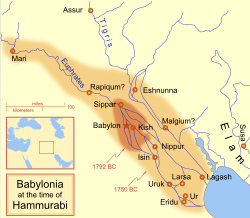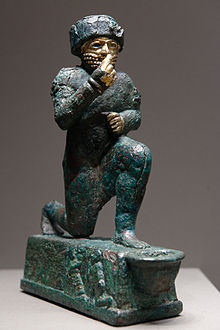Larsa
Λαραγχων) by Berossos and connected with the biblical Ellasar, was an important city-state of ancient Sumer, the center of the cult of the sun god Utu with his temple E-babbar.
It lies some 25 km (16 mi) southeast of Uruk in Iraq's Dhi Qar Governorate, near the east bank of the Shatt-en-Nil canal at the site of the modern settlement Tell as-Senkereh or Sankarah.
[3] Larsa is found (as UD.UNUG) on Proto-cuneiform lexical lists from the Uruk 4 period (late 4th millennium BC).
In a large victory stele found at Girsu he wrote: "... E-anatum was very clever indeed and he made up the eyes of two doves with kohl, and adorned their heads with cedar (resin).
[6] Larsa is attested in the Akkadian Empire in the Temple Hymns of Enheduanna, daughter of Sargon of Akkad.
"[7] In the Ur III empire period that ended the millennium, its first ruler Ur-Nammu recorded, in a brick inscription found at Larse, rebuilding the E-babbar temple of Utu there.
In his year names he recorded the defeat of the distant Anshan in Elam as well as city-states closer to Larsa such as Malgium.
[12][13][14][15] The E-babbar of Utu/Shamash was destroyed by fire in the 2nd century BC and the area re-used for poorly built private homes.
[20] Loftus recovered building bricks of Nebuchadnezzar II of the Neo-Babylonian Empire which enabled the site's identification as the ancient city of Larsa.
[26][27] Between 1976 and 1991, an expedition of the Delegation Archaeologic Francaise en Irak led by J-L. Huot excavated at Tell es-Senereh for 13 seasons.
They have been able to trace a very large system of internal canals and a port area, all linked to the Tigris and Euphrates rivers in Old Babylonian times.
In a destroyed level of the Grand Viziers residence 59 cuneiform tablets, fragments and envelopes dated to the time of Gungunum and Abisare were found.
Geophysical work continued including on the 10-20 meter wide rampart wall that enclosed Larsa, with six main gates.
















